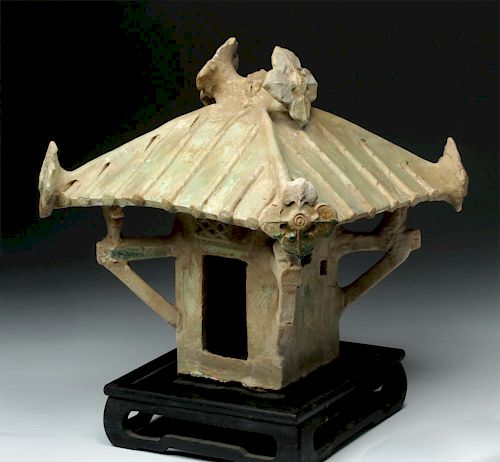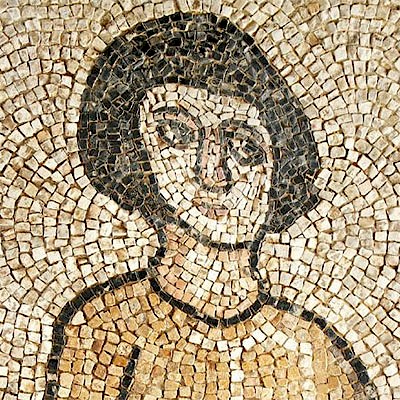Chinese Han Dynasty Green Glazed Pottery Pagoda
Lot 90c
About Seller
Artemis Fine Arts
686 S Taylor Ave, Ste 106
Louisville, CO 80027
United States
Selling antiquities, ancient and ethnographic art online since 1993, Artemis Gallery specializes in Classical Antiquities (Egyptian, Greek, Roman, Near Eastern), Asian, Pre-Columbian, African / Tribal / Oceanographic art. Our extensive inventory includes pottery, stone, metal, wood, glass and textil...Read more
Estimate:
$2,800 - $4,200
Absentee vs Live bid
Two ways to bid:
- Leave a max absentee bid and the platform will bid on your behalf up to your maximum bid during the live auction.
- Bid live during the auction and your bids will be submitted real-time to the auctioneer.
Bid Increments
| Price | Bid Increment |
|---|---|
| $0 | $25 |
| $300 | $50 |
| $1,000 | $100 |
| $2,000 | $250 |
| $5,000 | $500 |
| $10,000 | $1,000 |
| $20,000 | $2,500 |
| $50,000 | $5,000 |
| $100,000 | $10,000 |
| $200,000 | $20,000 |
About Auction
By Artemis Fine Arts
Aug 2, 2018
Set Reminder
2018-08-02 10:00:00
2018-08-02 10:00:00
America/New_York
Bidsquare
Bidsquare : Antiquities | Egypt, Greece, Italy, Asia
https://www.bidsquare.com/auctions/artemis-gallery/antiquities-egypt-greece-italy-asia-3352
Featuring two incredible collections - one in storage for more than 20 years! Artemis Fine Arts info@artemisgallery.com
Featuring two incredible collections - one in storage for more than 20 years! Artemis Fine Arts info@artemisgallery.com
- Lot Description
East Asia, China, Han Dynasty, ca. 206 BCE to 220 CE. A large green glazed earthenware model of a Han house created as a burial object or mingqi, to in essence 'stand in' for full-scale architecture, securing comfort for the deceased. This piece displays a characteristically sharply projecting curved tile roof accented with lovely lotus blossoms, this superstructure supported by a framework of posts, lintels, and brackets - in pottery as well, but imitating timber - with doorway and walls below showing openwork windows below. Interestingly, a great deal of Chinese architecture - even works created today - follows this construction method. Written descriptions of Han palaces suggest that they were actually relatively grand versions of this same type, only with more lavish decorations such as mural paintings and walls comprised of lacquered wood. Size: 14.25" W x 13.625" H (36.2 cm x 34.6 cm)
Although no Han Dynasty domestic edifices have survived, ceramic models of houses that were deposited in Han tombs provide a greater window of understanding about Chinese residential architecture as well as construction techniques used during this period. Models such as this example were created to represent everything from humble pig pens to multi-level watch towers to the most luxurious palaces. They were placed in tombs of the deceased in order to provide for the departed soul - ensuring that his / her needs would be met in the afterlife. In addition to architectural models, sculptures of musicians, animals, dancing figures, horses, oil lamps, and other items of daily life were created for the funerary environment. Although China’s pottery-making tradition began well before the Han dynasty, it was during this period that the most sophisticated techniques arose allowing for extensive production of works for both utilitarian and ceremonial use.
Similar examples may be found in fine museum collections such as the Asian Art Museum in San Francisco (B60P1802), the Metropolitan Museum of Art (1984.397a.b and 13.220.85a-d), Glascow Museums: The Burrell Collection, Freer Gallery of Art, Smithsonian Institution, and the British Museum (01613301163).
Provenance: ex private Ventura County, California, USA collection
All items legal to buy/sell under U.S. Statute covering cultural patrimony Code 2600, CHAPTER 14, and are guaranteed to be as described or your money back.
A Certificate of Authenticity will accompany all winning bids.
We ship worldwide and handle all shipping in-house for your convenience.
#129131Loss to rooftop finial. Considerable restoration, but done well in order to preserve the form. Expected surface wear with some remaining green glaze as shown.Condition
- Shipping Info
-
All shipping is handled in-house for your convenience. Your invoice from Artemis Gallery will include shipping calculation instructions. If in doubt, please inquire BEFORE bidding for estimated shipping costs for individual items.
-
- Buyer's Premium



 EUR
EUR CAD
CAD AUD
AUD GBP
GBP MXN
MXN HKD
HKD CNY
CNY MYR
MYR SEK
SEK SGD
SGD CHF
CHF THB
THB















